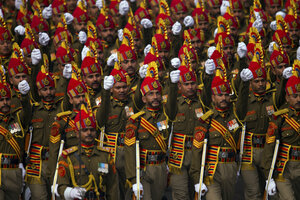Obama gets high India honor. Are better US-India ties on the way?
Obama will be the first US presidential guest of honor at India's grand parade on Republic Day, Monday. While Obama has called the US-India relationship pivotal in the 21st century, divides on trade, energy, geopolitics are deeper than advertised.

Indian soldiers marched down Rajpath, a ceremonial boulevard, during full dress rehearsal ahead of the Republic Day parade in New Delhi, India, Friday, Jan. 23, 2015. President Obama will be the first US presidential guest of honor.
Saurabh Das/AP
New Delhi
When President Barack Obama visited New Delhi in 2010, he described the US-India relationship as the “defining partnership” of the 21st century. But moving past a traditionally lukewarm relationship has been difficult.
President Obama and Indian Prime Minister Narendra Modi apparently hit it off last fall during a Modi visit to Washington – with Obama even giving his guest a spontaneous tour of the Martin Luther King Jr. memorial. Both men rose from modest backgrounds to lead their nations of 316 million and 1.2 billion, respectively, and this seemed to provide a common bond of communication.
Now it is Modi's turn to host Obama. Arriving Sunday, Obama will be the first American head of state to visit India more than once, and the first to be guest of honor at India’s significant Republic Day parade on Monday. Apart from the evident good personal vibes, the Sunday visit is intended to ameliorate a recent string of often-petty grievances. And officials from both governments have been working overtime to ensure the encounter delivers more than just a colorful handshake.
“This is an important visit. But it must go beyond the symbolism, which I think is no doubt important in itself,” says Kanwal Sibal, India’s former foreign secretary. “Both sides have to bridge differences on some key issues.”
Indeed, US-India divides are deeper than recognized, ranging from cold-war-era strategic outlooks to potential American investment. A brief issued Jan. 22 by the Carnegie Endowment for International Peace counsels the US president not to look for a quid pro quo with Modi, but to return to the approach Washington took with India at a time when the subcontinent often sided with the former Soviet Union and the US expected little.
Obama should think of building Indian ties as an “investment,” says report author Ashley Tellis of Carnegie.
Officials in New Delhi remain tight-lipped about what the leaders will discuss. Likely topics include US troop withdrawal in Afghanistan and its implications for India’s security, as well as border tensions between India and Pakistan. Trade is also a priority: In a special visit here earlier this month, US Secretary of State John Kerry said the US wants to one day increase bilateral trade from its current $97 billion figure to $500 billion, close to the current US-China trade figure. Secretary Kerry identified defense, trade, climate change, and nuclear power as the four key agenda items.
The problems – and the wide divides – lie in the details.
For example, while Obama and Chinese President Xi Jinping just agreed to a major greenhouse gas reduction target, India, one of the world’s leading emitter of greenhouse gases, has stoutly refused all requests to reduce its footprint, including coal burning.
And while American firms have been eager to build nuclear plants in the South Asian state, India has strict liability laws that are a sharp deterrent to potential business suitors. US trade officials complain that their counterparts in New Delhi imagine that Washington can easily or simply talk private firms out of their fears, and get them to invest.
One area of deeper cooperation, however, is defense. US-India military exercises have grown in frequency, and today the US is India’s biggest arms supplier, even if many of the heavy weapons Obama will observe during Monday’s parade are made in Russia. The visit is expected to yield a further phase of a defense agreement dating to 2005 involving technology transfer, research, and anti-terror measures.
And the two sides are almost drifting into agreement on more geopolitical issues. Both New Delhi and Washington, for example, were gratified when Sri Lanka’s pro-China presidential candidate unexpectedly lost his bid in elections earlier this month, an outcome likely to curb Beijing’s plan to increase its presence off India’s southern coast.
“It is clear that Washington has now come to accept the centrality of India to any future Asian pivot or re-balance,” argues Manoj Joshi, a defense analyst at Observer Research Foundation, a Delhi-based think tank.
And, Mr. Tellis argues in "Unity in Difference: Overcoming the US-India Divide," the Carnegie publication, "It is in US interests to bolster Indian power even if no repayment is forthcoming because doing so will help limit the rise of a Chinese hegemon in Asia that could undermine the enduring strategic interests of the United States,"
It's unclear, however, if the US would, as Tellis suggests, overlook the usual interest in actual deliverable deals and make India an exception on the basis of its inherent geographical and strategic positioning.
Obama's visit has generated huge excitement in India. Media here are agog with reports about his security, his agenda for talks, where Obama might travel and how he will get there. Obama is admired in India, largely for his support on India’s seat at UN, even if the endorsement is symbolic.
However, Obama’s predecessor George W. Bush is still more popular here, in part for his role in lifting strictures on India’s nuclear program. India surreptiTIously tested a nuclear device in the spring of 1998, which led to Pakistan testing a device less than a month later. Both tests were condemned by many in the international safeguards community and by the Clinton administration, at the time.

